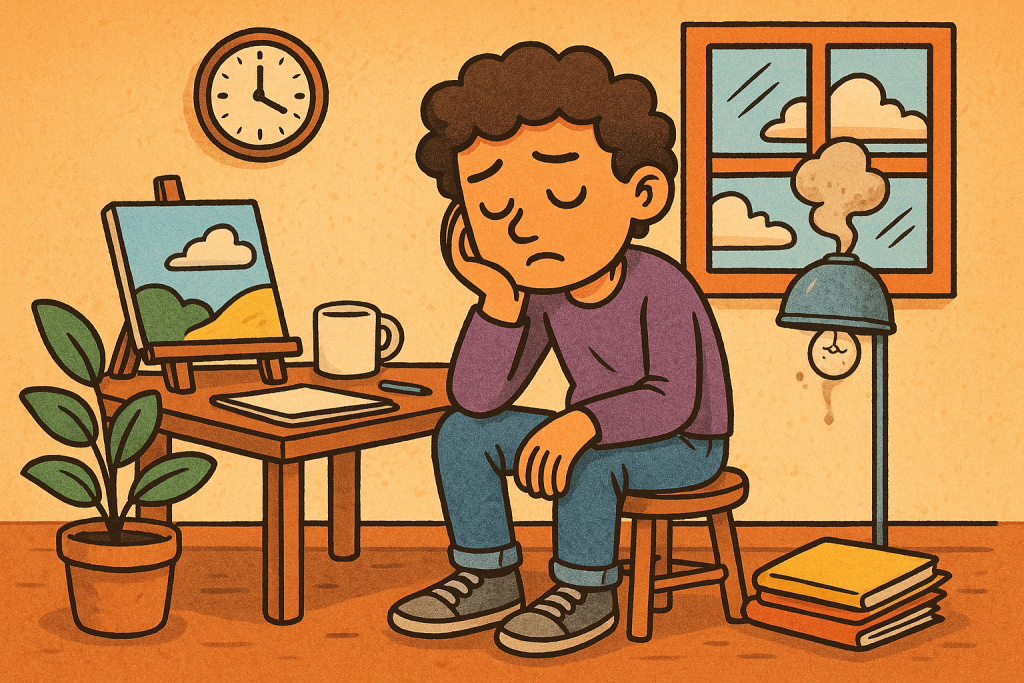Letting projects sit can feel counterintuitive. But the art of letting projects sit—knowing when to pause, recharge, and then re-engage—can be a powerful secret for productivity, creativity, and long-term success.
The art of letting projects sit isn’t procrastination; it’s strategic rest taken at the right time to come back stronger.

Why You Should Let Projects Sit (Strategically)
- Fresh Perspective & Problem-Solving
Studies show that micro-breaks, especially unexpected ones, can boost performance on complex tasks afterward. Pausing allows your brain to incubate ideas and uncover solutions you couldn’t while immersed. - Fighting Parkinson’s Law
If a task’s time limit is undefined, work will stretch to fill it. Pausing forces clear boundaries—“I’ll work for two hours, then pause”—preventing endless over-polishing. - Avoid Burnout & Maintain Momentum
Breaks reduce fatigue and maintain engagement. Letting projects rest encourages balance, keeping you energized for the final push.
When to Let Projects Sit: A Practical Guide
- After Intense Creative Sprints
If you’ve just poured energy into a draft, prototype, or design session, give it 24–48 hours before revisiting. - At Logical Pause Points
Complete milestones—a chapter, design mockup, or research summary—then pause. This leaves space to reflect on progress and next steps. - When Momentum Dips
If you hit a roadblock or feel stalled, walk away. Letting the unconscious mind take over is often more productive than grinding.
How to Let Projects Sit Without Abandoning Them
- Use Timeboxing & Forcing Functions
Schedule focused work followed by intentional timeout. The Kevin Eikenberry Group suggests blocking work and rest to counter Parkinson’s Law. - Log Progress & Questions
Before stepping away, note what you’ve done, what’s unresolved, and next steps. This preserves momentum and direction. - Set Revisit Reminders
Use calendar alerts or notifications to come back—avoid forgetting and prevent true abandonment. - Limit Interruptions During Breaks
Treat the pause like part of the project—to truly recharge, minimize distractions and let your mind rest. - Microproductivity During Pauses
Swap to smaller, low-pressure tasks (e.g., responding to emails, organizing files). These small wins keep you engaged without draining creativity.
Benefits You’ll Gain
A. Better Creativity
Breaks incubate ideas, fostering innovation and clearer solutions when revisiting the work.
B. Enhanced Accuracy
Returning with fresh eyes makes errors and gaps easier to detect—better quality in less time.
C. Emotional Well-being
Resting reduces stress, avoids burnout, and keeps motivation steady over long projects.
D. Efficient Resource Use
Pauses help prevent over-investment in details, aligning effort with value.
Tips from High-Performers
- Writers & Artists: Let drafts sit for days or weeks—this distance forces fresh insight during edits.
- Software Developers: Use review cycles with buffer periods; feature pauses prevent endless tweaking and support agile delivery.
- Product Teams: Google’s famous “20% time” allowed side projects to rest while core work continued.
- Corporate Tools: Atlassian’s “ShipIt” days build in breaks to refresh ideas and avoid burnout.
Common Misconceptions
- It’s Not Procrastination: You’re not avoiding work—you’re strategically pausing it.
- It Doesn’t Mean Delay: Timed breaks and scheduled revisits keep deadlines intact.
- Requires Discipline: Intentional pausing demands planning and trust in your process, not disorder.
Step-by-Step Routine (Letting Projects Sit)
- Plan Your Sprint – Define a block (e.g., 90 min) for focused work.
- Work Deeply – Dive in fully on the task.
- Wrap & Reflect – Spend 5 min summarizing progress and next questions.
- Pause Fully – Step away, ideally for at least one full Pomodoro (25 min) or longer.
- Re-engage With Notes – Use logs to jump back in smoothly.
- Review Fit – Reassess your bigger project goals—ensure alignment and avoid scope creep.
- Iterate Cycle – Repeat sprint, pause, reflect, progress.
The Science Behind It All
A Harvard Business School study confirmed that short, unexpected breaks often yield immediate post-break performance boosts. Other research shows rest supports cognitive recovery and learning retention. Combined, these insights prove strategic pauses enhance creativity, memory consolidation, and problem-solving.
Subheader With Keyphrase:
Master the Art of Letting Projects Sit to Boost Output
Practicing the art of letting projects sit isn’t just about breaks—it’s about clarity, efficiency, and finishing stronger.
Real-World Example: From Frustration to Flow
Imagine designing a website:
- You sketch wireframes non-stop for a day, then back away.
- A day later, reviewing you see layout flaws missed earlier.
- A 30-minute sprint to adjust, followed by another pause, refines copy and UX flow.
- Instead of endless tweaks, you finalize clean, ready-for-review designs in three paced sessions.
Final Thoughts
- Letting projects sit is a powerful strategy—closer to “smart pausing” than procrastinating.
- It balances creativity with discipline, rest with momentum.
- With structure—time blocks, notes, reminders—it becomes a tool, not a time-waster.
- You’ll return to your work sharper and more effective, ramping up quality without burning out.
References
1. Grant, A., & Shin, J. (2020). When putting work off pays off: The curvilinear relationship between procrastination and creativity. Academy of Management Journal. Published online via Penn Today. Retrieved from https://penntoday.upenn.edu
2. Lesser, C. (2018). Does procrastination make you more creative? Artsy Editorial. Retrieved from https://www.artsy.net/article/artsy-editorial-creative-geniuses-procrastinated
3. Wikipedia. (2024). Incubation (psychology). Retrieved from https://en.wikipedia.org/wiki/Incubation






